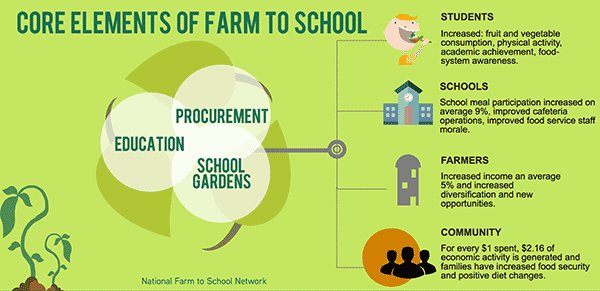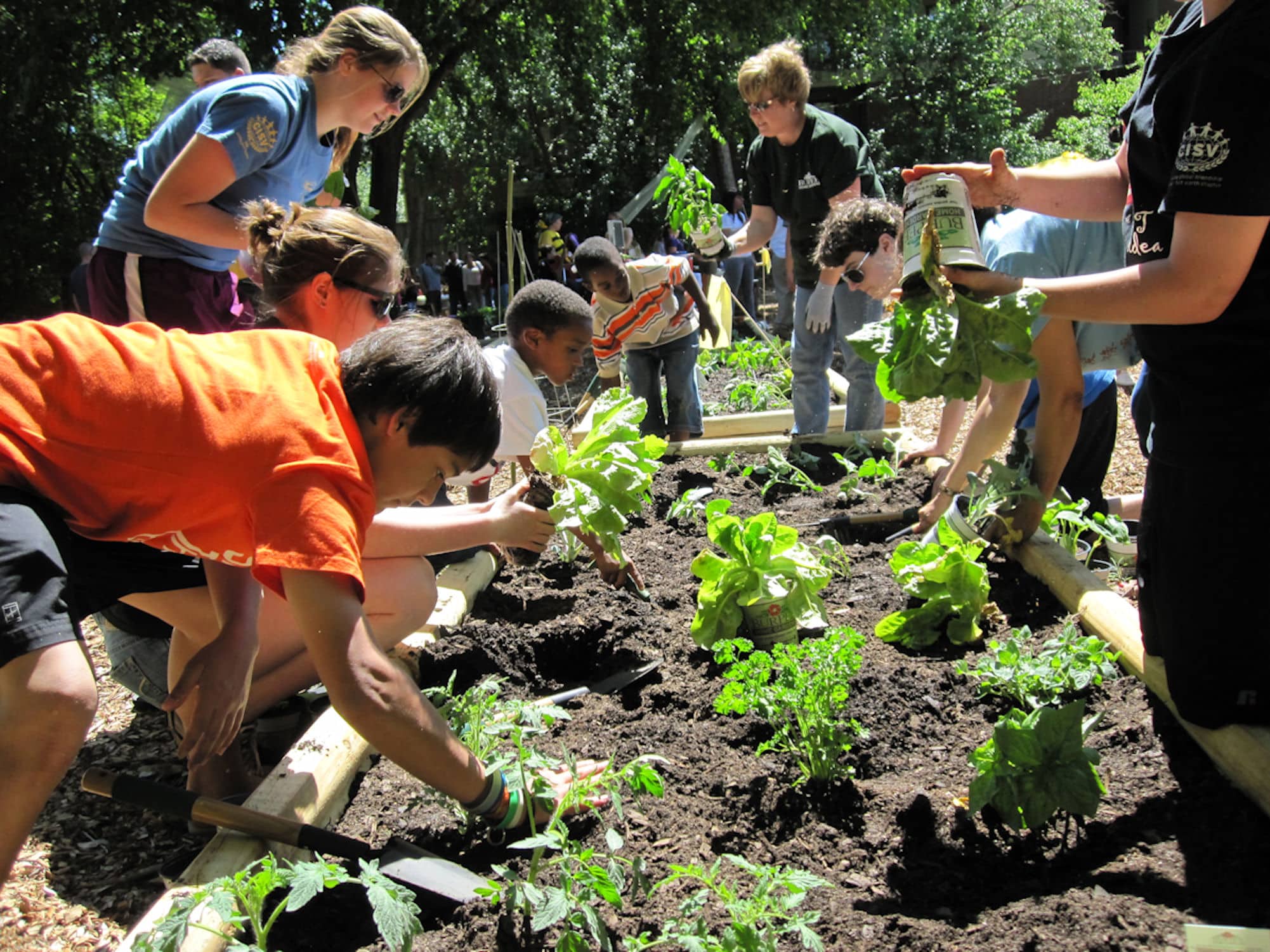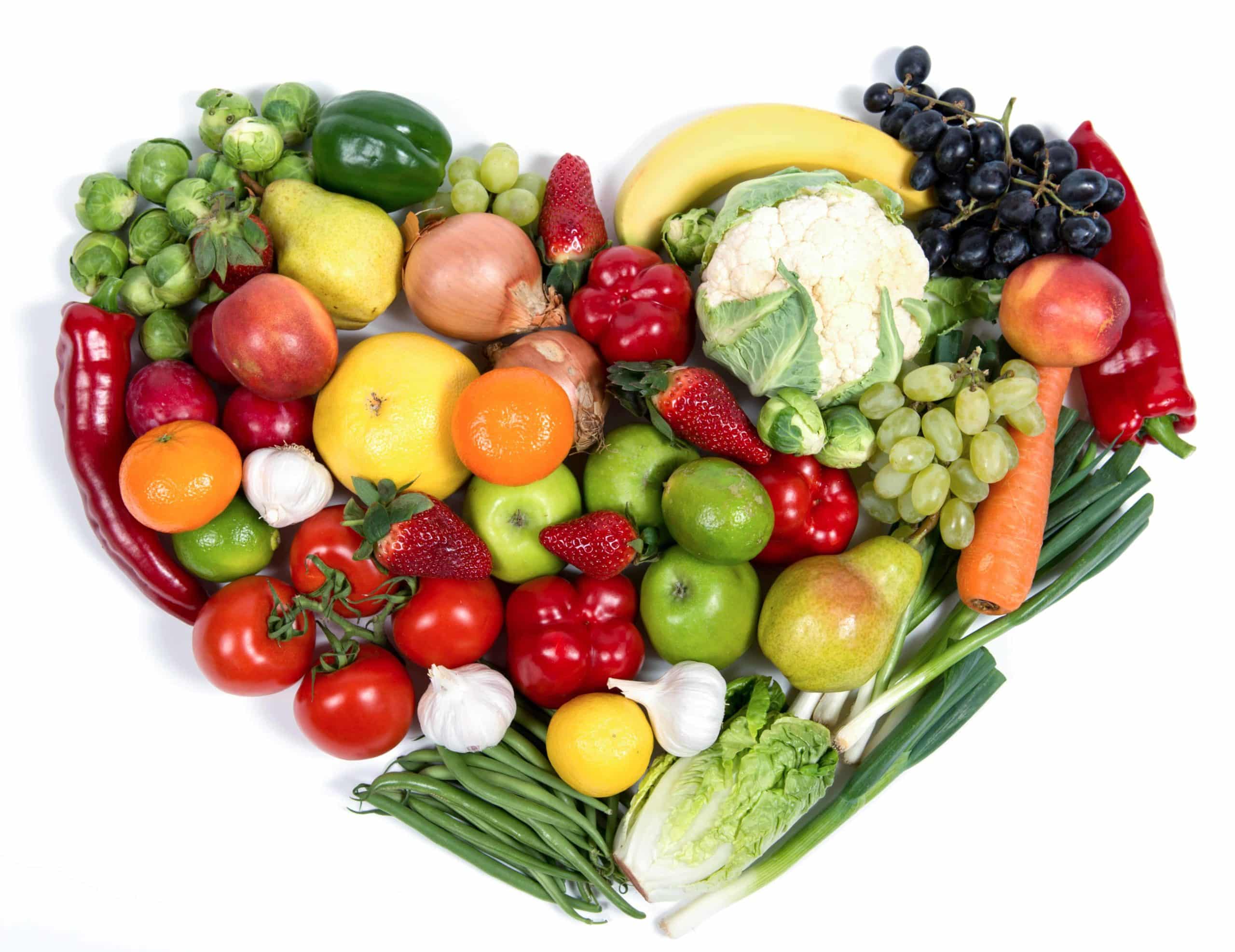Published August 19, 2019
The demand for local food has been on the rise for the last decade. Terms such as “farm-to-table” or “farm-to-glass” have become omnipresent in tandem with this growing demand for the hyper local. Whether it be food or beverage, the “farm-to” movement is becoming quite a big part of the zeitgeist. But what about Farm-to-School? Many people are aware of school gardens and the benefits of hands on learning, but Farm-to-School encapsulates much more than that.
Since the days of its inception in the early 1990’s, the Farm to School concept has always been “a school-based program that connects schools (K-12) and local farms with the objectives of serving local and healthy foods in school cafeterias or classrooms, improving student nutrition, providing health and nutrition education opportunities, and supporting small and medium-sized local and regional farmers.” 1 Farm to School is a unique concept in that it takes a holistic approach to health and nutrition, and works to strengthen not only growing bodies of students, but our local economies and communities. In 2010, then President Barack Obama signed into law the Healthy Hunger-Free Kids Act. This statute formally established the Farm to School program, which aims to “carry out a program to assist eligible schools, State and local agencies, Indian tribal organizations, agricultural producers or groups of agricultural producers, and nonprofit entities through grants and technical assistance to implement farm to school programs that improve access to local foods in eligible schools 2. Although over time states have opted to enact their own unique version of farm to school legislation, there are three core elements of the program: procurement, school gardens, and education. When implemented together, these three elements are what enables the Farm to School program to create community-wide change and strengthen the local food system. Each key aspect of the program has a specific set of goals:
Procurement: Local foods are purchased, promoted and served in the cafeteria or as a snack or taste-test;
School gardens: Students engage in hands-on learning through gardening; and
Education: Students participate in education activities related to agriculture, food, health or nutrition. 3
The procurement goals are creating a massive economic opportunity for local farmers. By prioritizing local food, regional farmers are seeing the benefits of a new institutional market opening up. Since 2013, 789 million dollars have been spent on local food that will flow directly into school cafeterias. This number is likely to grow with the introduction of the Kids Eat Local Act (H.R. 3220, S. 1817), which was introduced to Congress in June of this year. This landmark bill will be included in the next Child Nutrition Act Reauthorization (CNR) alongside the Farm to School program. Other communities could be seeing these economic benefits as well. According to research done by the national farm to school network, for every job created by school districts purchasing local foods, additional economic activity creates another 1.67 jobs. This means higher employment rates and increased cash flow directly impact communities where farm to school programs are implemented. These factors taken together is positioning the next Child Nutrition Act Reauthorization as one of the most lucrative opportunities for our regional farmers.
While the Farm to School’s local procurement strategy is a great opportunity for economic growth, the school gardens and education elements provide long term health benefits for students and the communities they live in. By incorporating a hands on education curriculum that allows students to interact with healthy vegetables, educators are allowing children to familiarize themselves with these foods, increasing the likelihood that they will grow to include these in their diets in the long term. Researchers at the Pew Charitable Trusts and The Robert Wood Johnson Foundation found that “When schools offer school gardens, 44.2 percent of students eat more fruits and vegetables; when schools serve local food, 33.1 percent of students eat more fruits and vegetables.” This openness also correlates to a demonstrated willingness to try new and healthier food options. The Farm to School network also reports on findings that show “Minimized diet-related diseases in childhood such as obesity and diabetes through the promotion of eating fresh fruits and vegetables, specifically for high-risk, low-income students.” This is important for those communities experiencing food apartheid; a term that is more encompassing than “food dessert,” and refers to neighborhoods that have plenty of corner stores or convenience stores, but require a trip to the grocery store by vehicle. While the demand for better, healthier options and larger grocery stores has always existed in these communities, more and more people are gaining awareness and understanding as terminology and concepts such as “Food Justice” is becoming more common place. School gardens help open the door for young leaders to advocate for access to larger grocery stores, farmers markets, and community gardens, ultimately benefiting the overall health of their communities.
Being at the front lines of food and nutrition, Gourmet Gorilla knows firsthand the value of exposing students to healthy food, and educating them on the long lasting benefits of a healthy diet. Similar to the Farm to School Network’s three core elements, Gourmet Gorilla focuses on sustainable sourcing, clean ingredients, and education. We partner with local food purveyors and farmers throughout the midwest to ensure we are supporting the growth of our local food system. This goes hand-in-hand with our guarantee for 100% clean label ingredients, because when you know where your food is coming from, there is an added level of transparency that ensures no additives, hormones, or mystery ingredients that no one can pronounce (dimethylpolysiloxane?!). We are in full support of the Kids Eat Local Act, and would love to see the return of a new CNR this year. The Act would help to implement much of the work we are doing all over the country, ensuring each student has access to the healthy food that they deserve.
Like with any program that works to create effective change, it may seem impossible or daunting learning how to get involved. Luckily, it is actually quite easy. The Farm to School Network is looking for your voices to help them prepare for the possible return of CNR this year. Not sure how you can help? Follow this link for some great resources that detail the best way to get involved to guarantee the passing of the CNR this year, because local food and school gardens are so much more than buzzwords; they ensure resilient, strong, and sustainable communities.
______________________________________________________________________________________
This post was written by Anna Crofts – Senior Client Account Representative




